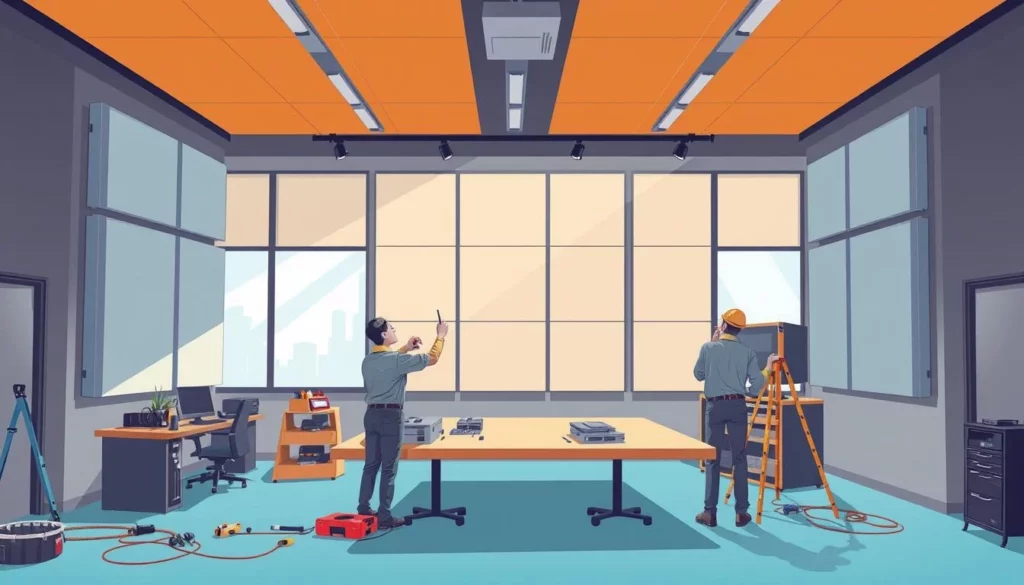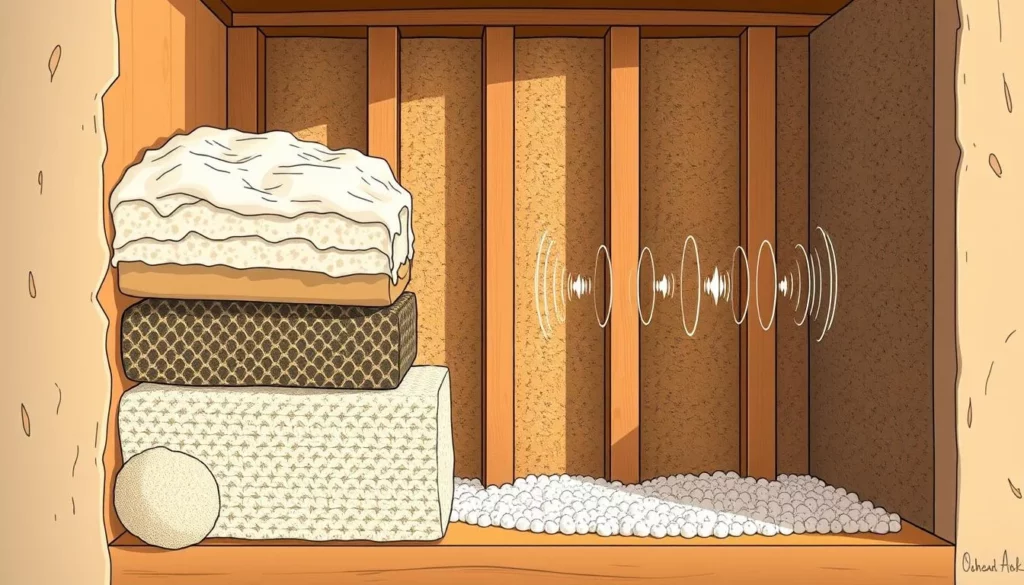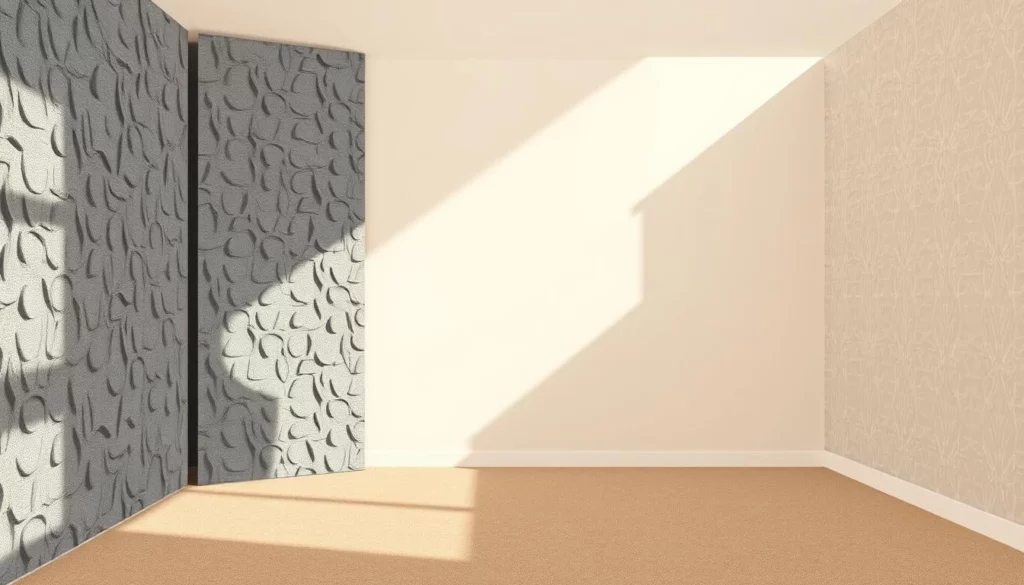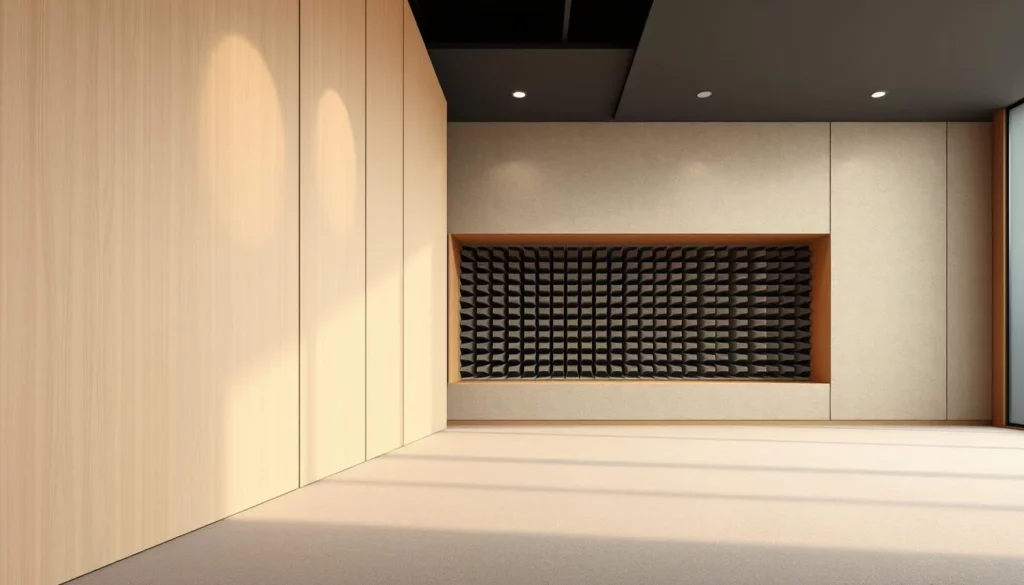Soundproofing helps cut down on noise and boosts privacy in places like offices and homes. It uses wall insulation that stops sound from passing through walls, ceilings, and floors. This is done by adding weight, using thick materials, and closing any openings. We’ll look at how soundproofing inside walls differs from outside walls, including what they’re used for, the difficulties they face, and their advantages.
Understanding Soundproofing Basics
Soundproofing uses various ways to stop sound from coming in or going out of a space. If you’re tired of noisy neighbors or want a peaceful space, knowing how to soundproof is key. This knowledge is essential for effective results.
What is Soundproofing?
Soundproofing blocks or reduces noise using special materials and building methods. It’s different from acoustic treatments, which improve sound inside a room. Soundproofing keeps unwanted noise away. Techniques involve mass-loaded vinyl, resilient channels, and sound isolation clips. These make a room quieter and more pleasant.
How Sound Travels
Understanding soundproofing starts with knowing how sound moves. It travels in waves, creating vibrations in the air and through objects. When it hits a barrier, it might pass through, bounce back, or get soaked up. Successful soundproofing reduces how much sound can get through barriers. Using acoustic insulation and heavy materials can block sound paths, making a big difference.
Types of Sound (Airborne vs. Impact)
Soundproofing tackles two main sound types: airborne and impact. Airborne sound includes noises like talking, music, and cars. Impact sound comes from things hitting a building, like footsteps or closing doors. A good soundproofing plan deals with both to work best. The right materials and methods greatly lower annoying noises.
For more details on turning loud areas into quiet ones, please visit Soundproof Walls 101.
Importance of Soundproofing in Your Home
Soundproofing is key to a calm home. It lessens noise pollution, making your space more peaceful. This upgrade offers many benefits, like a quieter environment.
Benefits of Reduced Noise Pollution
Noise reduction is a huge benefit of home soundproofing. It blocks out city noise and loud neighbors. By soundproofing walls, floors, and ceilings, you make your home quieter. This helps everyone feel better at home.
Enhancing Comfort and Privacy
Soundproofing also improves comfort and privacy. With better residential acoustics, your conversations stay private. It also keeps outside noise out, making your home a peaceful place.
Increasing Property Value
Soundproofing does more than make your home comfy. It also raises your home’s value. Buyers look for quiet, private homes. So, a soundproofed home can sell faster and for more money, thanks to its soundproofing perks.
| Soundproofing Aspect | Benefits |
|---|---|
| Reduced Noise Pollution | Diminishes external noises causing disturbances |
| Comfort and Privacy | Boosts privacy and creates a serene indoor environment |
| Property Value | Increases market desirability and resale value |
Key Differences: Interior vs. Exterior Soundproofing
Soundproofing makes your home quieter and more private. Interior and exterior soundproofing are different because they have different goals and use different techniques.
Purpose of Soundproofing
Interior soundproofing aims to cut down noise between rooms for more privacy and comfort. It’s great for homes with home theaters, study areas, or bedrooms. Exterior soundproofing blocks outside noises like traffic or construction, making indoors peaceful.
Installation Locations
Interior soundproofing focuses on walls, ceilings, and floors to reduce sound between rooms. Exterior soundproofing targets outer walls, windows, and sometimes roofs to keep out outside noise.
Materials Used
Interior and exterior soundproofing use different materials. For inside, it’s about acoustic panels, insulation batts, and soundproof drywall to block sound. Outside, materials like mass-loaded vinyl and double-glazed windows withstand the elements and block noise.
To pick the right soundproofing type, understand these differences. Talk with experts to address your home’s noise challenges, inside and out.
Interior Wall Soundproofing Explained
Mastering interior wall soundproofing is key for a quieter home. Different techniques and materials can help cut down on noise. These methods improve living comfort and might increase your home’s value. We’ll look at common methods, recommended materials, and the costs involved.
Common Techniques for Interior Soundproofing
Adding mass to walls is a popular, cost-effective soundproofing method. Installing dense materials like mass-loaded vinyl (MLV) helps block sound. Another strategy is using resilient channels to separate drywall from studs, lowering sound vibrations. Soundproof drywall, with gypsum and polymers, provides extra mass and sound damping.
Recommended Materials for Walls
Picking the right materials is vital for soundproofing success. Beyond MLV and resilient channels, interior insulation options include sound-absorbing foam panels and fiberglass insulation. These can go in walls to reduce noise. Green Glue, a special adhesive, turns sound into a tiny bit of heat, making it a top choice.
Cost Factors for Interior Soundproofing
Soundproofing costs vary with the methods and materials used. Soundproof foam panels and fiberglass insulation are budget-friendly. However, high-end options like soundproof drywall and Green Glue cost more. Labor costs matter too, especially for professional setups. Consider the noise reduction benefits versus the cost when choosing.
Exterior Wall Soundproofing Overview
Dealing with noise from outside means facing some tough challenges. This is because the weather changes and we need strong materials. We must find smart ways to block noise and still have things last a long time.
Challenges of Outdoor Soundproofing
Reducing noise from the outside involves handling sounds from cars, building sites, and local activities. We need materials that last through rain, snow, and heat. They must also be good at stopping or soaking up sound.
Effective Materials for Exterior Walls
Finding the right exterior soundproofing materials is key. Some top choices include:
- Mass-loaded vinyl (MLV): This acts as a heavy barrier to keep sound out.
- Acoustic panels: Made of fiberglass or foam, these panels soak up noise. They’re great for cutting down outdoor noise reduction.
- Caulking and sealants: These fill in cracks to stop sound from sneaking through.
- Insulation material: This adds bulk and soaks up sound inside walls.
Cost Considerations for Exterior Solutions
Planning for outdoor soundproofing also means looking at costs. Let’s compare different options:
| Material | Average Cost per Square Foot | Durability | Effectiveness |
|---|---|---|---|
| Mass-loaded vinyl (MLV) | $2.50 – $3.50 | High | Excellent |
| Acoustic panels | $3.00 – $5.00 | Medium | Good |
| Caulking and sealants | $0.50 – $2.00 | Medium | Moderate |
| Insulation material | $1.00 – $1.50 | High | Excellent |
Noise Sources to Consider
Finding out what noises you must deal with is key to choosing the best soundproofing plan. Cities usually have more kinds of noises than the countryside. To soundproof well, it’s vital to know about both outside and inside noises.
Identifying Common Noise Sources
Your house might face various noises, like cars, building works, and loud talks from next door. Recognizing these helps start your journey to better indoor sound control. Knowing the noise source guides you to pick proper soundproofing methods.
Impact of Urban vs. Rural Noise
City noise, like honking, sirens, and crowds, can really affect your day. In contrast, country life might deal more with sounds from animals. Each setting has its own noise problems that need unique soundproofing approaches.

Indoor Noise: What You Should Know
Noises inside, from appliance sounds, footsteps on floors, or nearby voices, can be disturbing. Managing them means spotting these sources and using solutions like thick rugs, sound panels, and sealing gaps to lessen their effect.
| Noise Source | Urban Environment | Rural Environment |
|---|---|---|
| Traffic | High | Low |
| Construction | Frequent | Rare |
| Wildlife | Occasional | Frequent |
| Neighboring Conversations | Frequent | Rare |
| Appliance Noise | Moderate | Moderate |
Selecting the Right Soundproofing Method
Choosing the best soundproofing approach means looking at several key factors. You need to know the noise’s nature and decide on a pro or DIY method. This guide aims to help you make a smart choice.
Factors to Consider
Think about the noise’s type and where it comes from, the space’s layout, and your budget. These aspects affect which soundproofing methods will work best. Expert advice from a soundproofing pro can offer tailored solutions.
Assessing Your Noise Problems
Identifying what kinds of noise you’re dealing with is key. Figure out if the noise is from the air, like cars and talking, or from impacts, like footsteps. Mixing DIY efforts with expert advice gives a full picture of what to tackle.
Professional vs. DIY Soundproofing
The choice between pro and DIY soundproofing depends on a few things. A pro can give custom tips and top-notch installation for the best noise control. DIY methods are cheaper and more flexible. But they might not work as well as pro solutions.
Acoustic Treatments vs. Soundproofing
Acoustic treatments and soundproofing play different roles in managing noise and making sound better in a place. They are both crucial for great sound control but they solve different problems. Often, using them together brings out the best results.
Understanding Acoustic Treatments
Acoustic treatments improve room sound by managing reflections, echoes, and reverberations. They use things like acoustic panels, bass traps, and diffusers. These absorb or scatter sound to make acoustics clear and balanced.
How They Differ from Soundproofing
Soundproofing is about stopping sound from coming in or going out of a room, to keep it quiet. It uses special techniques and materials, such as mass-loaded vinyl and double-glazed windows. Knowing the difference between soundproofing vs sound absorption helps solve noise problems well.
When to Use Each Method
Choose acoustic treatments to better the sound inside a space, like a recording studio or home theater. Soundproofing is best for blocking outside noise or keeping sound in. Using both methods together usually gives the best control over noise and sound.
Understanding how acoustic treatment benefits work with soundproofing can make the sound in any interior better. Choosing the right method for the right situation improves sound control. This makes a place more comfortable and useful.
Case Studies: Successful Soundproofing Projects
Looking at both good and bad soundproofing projects teaches us a lot. This is true for places where people live and work. By studying different soundproofing projects, we learn what works and what doesn’t.
Residential Soundproofing Success
In homes, quiet and privacy are key. A New York City apartment provides a perfect example. The residents used a mix of heavy vinyl and special panels to block city sounds. This smart approach greatly reduced outside noise, making their home much more peaceful.
Commercial Soundproofing Best Practices
Places like offices and music studios need specific soundproofing strategies. A famous music studio in Los Angeles highlights this. They installed special windows and thick doors, along with sound-absorbing walls, to create the best sound. This setup ensured recordings were clear, without any unwanted noise.
Lessons Learned from Failed Projects
Not every soundproofing attempt is successful. A big issue often seen is not using enough of the right materials. For example, a new office in San Francisco didn’t use enough sound blocking materials, leaving them with a noisy workspace. Failed attempts like this show how crucial proper planning and the right materials are for successful soundproofing.
| Project Type | Materials Used | Outcome |
|---|---|---|
| Residential – NYC Apartment | Mass-loaded vinyl, Acoustic Panels | Significant noise reduction; Enhanced comfort |
| Commercial – LA Recording Studio | Double-glazed windows, High-density doors, Bass traps | Optimal sound isolation; Improved recording quality |
| Commercial – SF Office | Inadequate Insulation | Persistent noise issues; Inadequate soundproofing |
The Future of Soundproofing Technology
Soundproofing technology has advanced, leading to smarter, more efficient methods. We are heading towards a quieter, eco-friendly future. New trends are appearing. They improve soundproofing and focus on being green.
Innovations in Soundproofing Materials
Modern soundproofing brings innovative materials to the forefront. Brands like 3M and CertainTeed have developed better noise reduction materials. These include multilayer composites for blocking sound more effectively. Nanotechnology is also making soundproofing thinner and lighter.
Smart Soundproofing Solutions
Smart technology is changing soundproofing too. Walls that adjust their sound-absorption based on noise are now real. Smart panels and IoT setups offer dynamic noise control. Systems from Sonobuoy and Sony can be smartphone-controlled, adding convenience.
Trends in Sustainable Soundproofing
There’s a push for green building methods. Sustainable acoustic solutions are more popular. Recycled materials are now used in soundproofing. Recycled cotton and hemp make effective sound barriers. This approach reduces environmental harm and avoids toxic chemicals.
Legal and Code Considerations
Starting a soundproofing project means understanding the rules involved. This ensures you follow local laws and avoid problems later. We’ll cover the important legal stuff and how to follow building codes.
Understanding Local Building Codes
Building codes change depending on where you are. They set the basic rules for building and remodeling to keep things safe and working. You must follow these codes to the letter. Talk to your local building office to find out what rules apply to you.
Soundproofing Regulations in Residential Areas
In places where people live, soundproofing rules help reduce noise. They might specify how loud sounds can be, what materials to use, and how to build things. Knowing these rules helps make sure your project keeps things quiet and peaceful.
Best Practices for Compliance
Following best practices is crucial for meeting code requirements. Here are tips to help you stick to the rules:
- Consult with professionals: Talk to experts in building or soundproofing to understand the complex legal stuff.
- Documentation: Keep detailed notes on what materials and methods you use. This is essential for passing inspections.
- Stay Updated: Rules can change, so it’s important to keep up with the latest requirements for ongoing compliance.
By focusing on soundproofing laws and code compliance, your project will be successful. It will improve comfort and meet all the necessary standards.
Conclusion: Making the Best Choice for Your Needs
We’ve learned that soundproofing inside and outside walls comes with different benefits and issues. Whether you want to block city sounds or make your home quieter, knowing these key points helps you choose wisely.
Recap of Key Differences
Soundproofing inside walls helps improve comfort by lowering noise from room to room. Techniques include using materials like mass loaded vinyl and acoustic panels. Exterior wall soundproofing focuses on stopping outside noise with strong materials like double-pane windows and specific barriers.
Tailoring Your Approach to Soundproofing
Pick a soundproofing method that fits your situation and what you’re trying to achieve. Think about the noises you face, where sound gets in, and what materials and methods will work best. For more help, check out this guide on soundproof walls.
Next Steps for Your Soundproofing Project
To wrap up your soundproofing plans, start by evaluating the noises at your place and your budget. Decide if you can do it yourself or need expert advice. With the right prep, you can find soundproofing solutions that fit your needs perfectly and make your space better.




